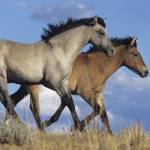Feral Horse Populations on the Rise

The latest estimate made by the Bureau of Land Management (BLM) puts the number of free-roaming feral equines at about 40,600 wild horses and burros in 10 states in the southwest region of the U.S. With virtually no natural predators, wild horse and burro herds tend to increase at a rate of 15 to 20% annually, and can double about every four years if conditions are favorable. In addition to these unconfined equines, the BLM holds another 48,000 horses and burros in corrals and fenced pastures.
All wild horses and burros, whether free-ranging or in holding areas, are protected by the BLM under the 1971 Wild Free-Roaming Horses and Burros Act. The act gave federal agencies the task of managing the feral horses. Management was to include protection of the horses, monitoring the population, and removing horses when the population grew too large for the habitat.
Horses have been periodically collected from open rangeland because the total population exceeded the number that is accepted as the maximum carrying load that the rangeland resources and uses can tolerate. Sick horses can be euthanized, but the BLM is not allowed to euthanize healthy horses. They can be offered for public adoption, but are not released back onto the open range. Any horses that are not adopted are transferred to corrals for the short term and fenced pastures for the long run. The cost of keeping these horses uses the majority of the BLM’s annual budget for feral equines.
At present, it is estimated that there are about 14,000 more feral equines on open rangeland than the optimal number of around 26,700. The BLM’s top number of confined horses that can be managed and cared for is just over 52,000, so if the excess free-ranging animals were removed to holding pens or pastures, they would exceed the capacity of the agency. Contraceptive programs are expensive and require hands-on treatment of the horses. At present, no effective solution to this situation has been proposed.








